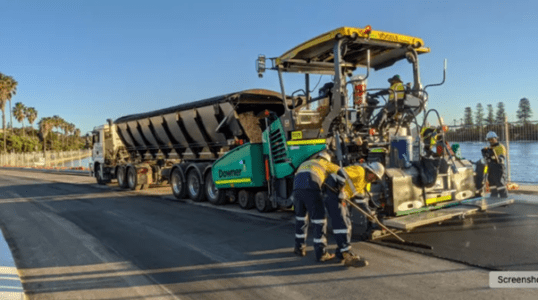A Sustainable Approach: Use of Plastic Waste in Pavement
Roads running through Accra, Ghana`s capital, look like any other blacktop surface. What most drivers don`t realize is that the asphalt used for some of Accra`s streets contain a slurry of plastics—shredded and melted bags, bottles, and snack wraps—that otherwise were destined for a landfill. The impetus for many similar road projects underway in Ghana was an ambitious plan announced by President AkufoAddo in 2018. It calls for Ghanaians to strive for a circular model, to recycle and reuse as much plastic waste as they produce each year—roughly 1.1 million tons—by 2030. Barely 5% of the 5000 tons of plastic that Ghanaians discard each day makes it to recycling facilities. The rest end up in landfills, illegal garbage dumps, roads, waterways, or are burned in open pit mines to poison the air. In developing countries, “plastic recycling is difficult,” According to Heather Troutman, Program Manager, National Plastics Action Partnership, Ghana, plastic recycling is difficult in developing countries. He also added that it is expensive, complex, technical, and much easier to just burn, but if it is possible to evaluate recycled plastic” by turning it into fishing nets, fuel, or pavement.

First introduced in India 20 years ago, plastic roads are being tested and built in more and more countries as the global problem of plastic pollution becomes more serious. India has installed these roads for over 60,000 miles. Meanwhile, this technology is increasing in the UK, Europe and Asia. Several countries, including South Africa, Vietnam, Mexico, the Philippines and the United States, have just recently built their first plastic roads. More and more research states that roads with plastic waste may function as well as or better than traditional roads. They are long lasting, stronger in terms of load and rutting, more durable, able to withstand large temperature fluctuations, and more resistant to water damage, cracks and dents. Researchers have discovered that this technology can regenerate small to large amounts of plastic from landfills and unplanned landfills, while at the same time providing significant amounts for road construction and repair.
Technology for incorporating waste plastic into paving materials can be time-consuming to develop. Widespread in India, but still in its infancy in other countries. But with only 9% of 350 million tonnes of plastic humans recycling each year, proponents have abandoned the technology and the habit of blindly transporting waste for them. Different companies have taken different approaches, but the general idea is to melt the plastic waste and mix it with other ingredients to make pavement asphalt. If the construction company adds waste plastic, this may act as a more powerful binder than the percent, but some processes need more, but often 4-10 of the percent. According to a study, “The use of plastic waste in road construction significantly improves the stability, strength, fatigue life and other desirable properties of asphalt compounds, improving life and pavement performance,” said the University of Birmingham.
According to Toby McCartney, co-founder and CEO of MacRebur, using plastic waste in road construction can absorb large amounts of waste plastic. By then, it`s smaller than we want. ” According to the company`s website, to a ton of MacRebur mix. For every 1km of road paved with this product, the weight of about 750,000 plastic bags is included. The MacRebur plastic material is shredded to the size of a grain of rice, packed in bags and sold to construction and asphalt companies around the world. Since the launch of MacRebur in 2016, its materials have been poured into hundreds of kilometers of roads, paths, driveways and parking lots in Turkey, Japan, Saudi Arabia, Dubai, Australia and New Zealand. In another approach, Plastic Road in the Netherlands will completely abolish traditional asphalt.
In India, where 50% of the country’s roads were unpaved just a few years ago, up to 14,000 miles of new roads have been built since the Minister of Road Transport and High School of India mandated the disposal of plastic waste on asphalt roads in 2016. it was done. India’s plastic road technology emerged in 2001 from an experiment by R. Vasudevan, a professor of chemistry at the Chiagaraja Institute of Technology in Madurai. He saw the similarities between plastic and bitumen, both made from petroleum, and mixed the crushed plastic with gravel and then with bitumen, and saw good adhesion. Vasudevan’s method is reported to use two types of plastic. LDPE (low density polyethylene used for plastic bags) and PET (polyethylene terephthalate used for beverage bottles). McCartney of MacRebur recalled being in India in 2016 and noticed that people were closing holes with plastic bags and igniting them to repair them. It gave him the idea behind MacRebur.
One problem is that heating plastic to produce asphalt produces CO2 emissions, which can negate emission reductions by reducing bitumen usage. Vasudevan says that in his way, the plastic only needs to be heated to 170 ° C (338 ° F), which is within safe limits. According to Troutman, the road material is relatively inert and is a hard mass of asphalt. Pile said that the tire wear is the largest source of microplastics on the planet. That was the first attempt at plastic. He also said he is aiming for “higher strength” by adopting a new construction method. Troutman saw plastic roads as a “promising step forward”, especially in countries like Ghana that are lagging behind road projects.
Reference
GreenBuildingAdvisor. (2021). Paving With Plastic Could Help Reduce Global Waste. [online] Available at: https://www.greenbuildingadvisor.com/article/paving-with-plastic-could-help-reduce-global-waste [Accessed 10 Dec. 2021].


 by
by